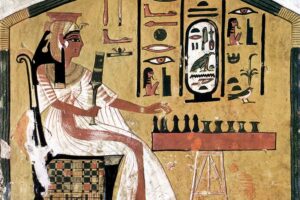On July 21, Napoleon and his 25,000 soldiers had to stop on their way to Cairo. Just four kilometers outside the town, they were met by an equally large army, manned by Mamluks. Their leader, Murad Bey, was confident of victory:
“My men will destroy you and I will cut off your heads like watermelons”.
The Mamluk horsemen were feared by their furious attacks, but Napoleon’s troops calmly formed themselves into five columns, each column consisting of six to ten ranks of soldiers.
“Robbery and robbery insult us and make enemies of the people we want to have as friends”
said Napoleon in his instructions to his men in Egypt.
When Murad Bey’s horsemen charged, the leading Napoleonic soldiers knelt down and fired their guns. This was repeated by the ranks behind the page. The aftermath can best be described as a carnage.
When the battle ended, about 20,000 Mamluk soldiers were left behind and Murad Bey fled.
Napoleon marched into Cairo. Now Egypt belonged to him, as well as the pyramids and the Sphinx of Giza.
The Sphinx is said to have received harsh treatment when the French fired at it. That’s how he lost the tip of his nose, the story says, but were Napoleon’s soldiers ribald?
Pros and cons: Tourists heard the following from locals
Around the turn of the 1900s , Egyptians told British tourists in Giza that Napoleon’s soldiers had shot the nose off the Sphinx.
The British visitors repeated the story in their travelogues. “Napoleon, that economical man, fired a few cannonballs at the face of the Sphinx,” author Cecil Sommers wrote in his 1919 book Temporary Crusaders.
Louis Farrakhan, spokesman for the controversial American organization Nation of Islam, declared in 1995 that Napoleon had “shot the nose off the Sphinx”.
If anything, Farrakhan had to destroy his nose because it reminded the French general of the supremacy of the black man.
Local guides in Egypt may have told tourists the fable that the French had shot the Sphinx. They probably hoped that the British, France’s arch-enemy, would like the story and reward it with a generous tip.
The Arab historian Al Maqrizi wrote in the 15th century that a Muslim leader named Muhammad Sa’im al-Dahr had ordered the nose to be removed in 1378. The reason was supposed to be that the Egyptians worshiped the sphinx as a kind of god.
A Danish naval officer named Frederik Ludvig Norden went to Egypt in 1737. During his stay, he drew a picture of the sphinx which shows beyond any doubt that it is missing its nose. This was 61 years before Napoleon invaded the country.
CONCLUSION: Archaeologist overturns theory of Napoleon’s involvement in the noseless
The proof that the sphinx was noseless in 1737 shows that Napoleon and his soldiers could not possibly have cut off the nose when they invaded and occupied the country in 1798-1801.
No one knows for sure how the sphinx lost its nose. American archaeologist Mark Lehner (born 1950) has conducted detailed studies of the face of the Sphinx, which has revealed that it lost its nose sometime between the 3rd century and the 10th century AD.
Traces indicate that the nose was chopped off with a hammer and chisel.
Lehner’s discovery dispels the myth that the Muslim leader Muhammad Sa’im al-Dahr had his nose removed in 1378. Why the nose was removed remains a mystery that awaits explanation.










